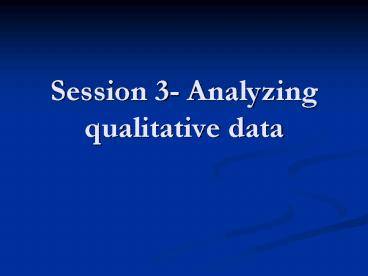Session 3 Analyzing qualitative data - PowerPoint PPT Presentation
1 / 13
Title:
Session 3 Analyzing qualitative data
Description:
First pass through recently collected data ... Verbatim examples. Narrative form. Tables. Case examples. Writing Results & Discussion ... – PowerPoint PPT presentation
Number of Views:255
Avg rating:3.0/5.0
Title: Session 3 Analyzing qualitative data
1
Session 3- Analyzing qualitative data
2
Creating Themes
- Neuman (2003) offers a 5 part plan for creating
themes in qualitative analysis - Sorting and Classifying
- Open Coding
- Axial Coding
- Selective Coding
- Interpreting and Elaborating
3
Step 1
- 1) Sorting and Classifying
- Data are organized around research questions or
interview questions - Neuman, W.L. (2003). Social Work Research
Methods Qualitative and Quantitative Approaches.
Boston Pearson Education.
4
Step 2
- 2) Open Coding
- First pass through recently collected data
- Researcher locates themes and assigns initial
codes or labels in an attempt to condense mass
data into categories - Slowly reads data looking for critical terms, key
events, or themes - Observations are labeled
- Neuman, W.L. (2003). Social Work Research
Methods Qualitative and Quantitative Approaches.
Boston Pearson Education.
5
Step 2 (continued)
- 2) Open Coding
- Themes/labels are created based on
- Research Questions
- Literature Review
- Terms used by members in the social setting
- Open Coding concludes with the formation of
definitions/qualifications for themes/categories - Neuman, W.L. (2003). Social Work Research
Methods Qualitative and Quantitative Approaches.
Boston Pearson Education.
6
Step 3
- 3) Axial Coding
- Second pass through data
- Begins with a set of initial codes
- In the second pass, focus more on initial codes
than on data - Additional codes or new ideas may emerge
- New themes are created
- Neuman, W.L. (2003). Social Work Research
Methods Qualitative and Quantitative Approaches.
Boston Pearson Education.
7
Step 3 (continued)
- 3) Axial Coding
- Moving toward organizing themes and identifying
axis of key concepts - Ask about causes, consequences, conditions,
interactions, and process, and look for
categories or concepts that cluster together. - Neuman, W.L. (2003). Social Work Research
Methods Qualitative and Quantitative Approaches.
Boston Pearson Education.
8
Step 3 (continued)
- 3) Axial CodingCritical Questions
- Can I divide existing concepts into sub
dimensions or subcategories? - Can I combine several closely related concepts
into one or more general ones? - Can I organize categories into sequence or by
their physical location (where they occurred)? - Neuman, W.L. (2003). Social Work Research
Methods Qualitative and Quantitative Approaches.
Boston Pearson Education.
9
Step 4
- 4) Selective Coding
- Last pass through the data
- Scanning data and previous codes
- Look selectively for cases that illustrate themes
- Major themes and concepts guide the search
- Neuman, W.L. (2003). Social Work Research
Methods Qualitative and Quantitative Approaches.
Boston Pearson Education.
10
Step 5
- 5) Interpreting and Elaborating
- Major themes and categories are related to the
literature (existing knowledge base) - Comparisons and contrasts are drawn
- Explanations are offered for the findings
- Concepts are organized and working theory
(explanations) is formulated - Neuman, W.L. (2003). Social Work Research
Methods Qualitative and Quantitative Approaches.
Boston Pearson Education.
11
Presenting Data
- Explain to the reader how the data will be
presented - Verbatim examples
- Narrative form
- Tables
- Case examples
12
Writing Results Discussion
- Chapter IV
- Presentation of Themes and Data to Support
Themes. (Open, Selective and Axial Coding
Process.) - Chapter V
- Elaboration and Interpretation (Step 5)
13
Issues to Consider
- Will analysis process be conducted by one
individual? (Strengths and Weaknesses) - Will the analysis involve transcription of all
data? (Strengths and Weaknesses) - Have I provided enough information so that
someone could replicate my process? - Am I clear what I am going to do?































